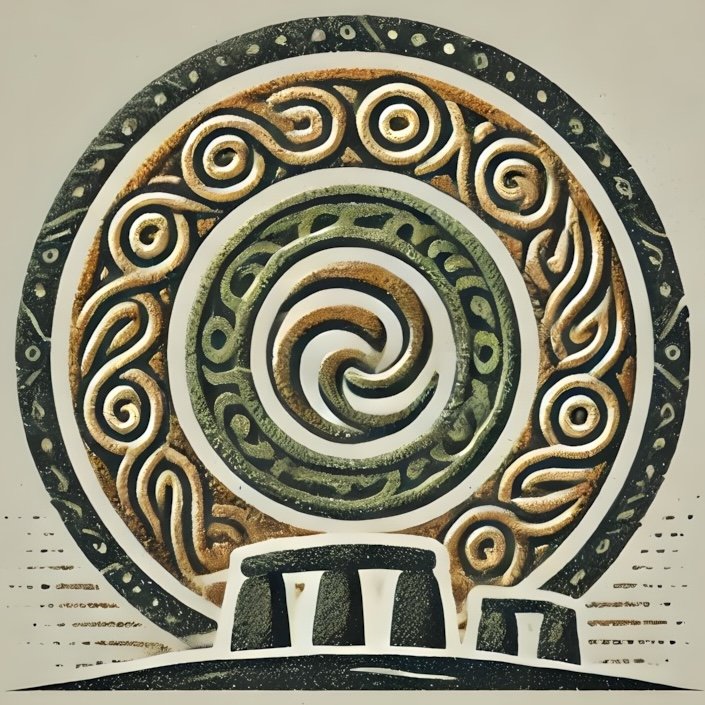Art and Symbolism in Megalithic Ireland
Introduction to Megalithic Art
Megalithic Ireland, a land steeped in ancient history, is home to some of the most remarkable stone structures in the world. These monumental edifices, erected between 4000 and 2000 BCE, are not merely architectural feats; they are canvases of human expression, rich in symbolism and artistry. From the intricate carvings on passage tombs to the imposing stone circles, megalithic art serves as a window into the spiritual and social lives of our prehistoric ancestors. This art is not just decorative; it embodies beliefs, rituals, and a profound connection to the landscape and cosmos.
Artistic Techniques and Materials
The artistry of megalithic Ireland is characterized by its use of local materials and innovative techniques. The primary medium was stone, often sourced from nearby quarries. The builders utilized tools made from harder stones, such as flint and quartz, to carve intricate designs into the surfaces of the megaliths. Techniques varied from pecking and incising to polishing, creating a diverse range of textures and patterns.
One notable site is Newgrange, a passage tomb in County Meath, where the entrance stone is adorned with a mesmerizing array of spirals, lozenges, and zigzag motifs. These designs were not randomly chosen; they were imbued with meaning, reflecting the beliefs and cosmology of the people who created them. The use of light and shadow in these structures also played a significant role, particularly during solstices, when sunlight would illuminate specific carvings, further enhancing their spiritual significance.
Symbolic Motifs and Themes
The symbolism in megalithic art is both complex and multifaceted. Common motifs include spirals, circles, and meandering lines, which are thought to represent concepts such as eternity, the cycle of life, and the interconnectedness of all things. These symbols often evoke natural elements, suggesting a deep reverence for the earth and its cycles.
Spirals, for instance, are prevalent in many megalithic sites, including the famous carvings at Knowth. They may symbolize the journey of life, the passage of time, or the movement of the sun across the sky. Similarly, the use of concentric circles can represent the cosmos or the community, emphasizing the importance of social cohesion and shared beliefs.
Other motifs, such as anthropomorphic figures and zoomorphic representations, hint at the spiritual beliefs of the people. These figures may represent deities, ancestors, or the natural world, suggesting a rich tapestry of myth and ritual that permeated their society.
Functions of Megalithic Art
The functions of megalithic art extend beyond mere decoration; they served as vital components of ritual and community life. Many of these structures functioned as tombs, where the dead were interred with great reverence. The art within these tombs likely played a role in the funerary rites, facilitating a connection between the living and the deceased.
Moreover, megalithic art acted as a form of social cohesion, reinforcing community identity and shared beliefs. The creation of these monumental structures required collective effort, fostering a sense of belonging and purpose among the builders. The art itself became a means of communication, conveying stories, beliefs, and values across generations.
In addition to funerary purposes, some megalithic sites, such as stone circles, may have served as gathering places for rituals and ceremonies. The art within these spaces would have played a crucial role in the performance of these rites, marking significant events in the agricultural calendar, such as solstices and equinoxes.
Regional Variations in Art and Symbolism
Ireland’s megalithic art exhibits remarkable regional variations, reflecting the diverse cultural practices and beliefs of its ancient inhabitants. In the Boyne Valley, for example, the art is characterized by intricate carvings and a focus on cosmological themes. In contrast, the west of Ireland, particularly in the Burren region, features more abstract designs and a greater emphasis on the natural landscape.
The differences in artistic expression may also indicate variations in social organization, trade networks, and interactions with neighboring cultures. For instance, the presence of similar motifs in both Ireland and Scotland suggests a shared cultural heritage, while distinct local styles highlight the uniqueness of each community’s beliefs and practices.
Connections to Irish Mythology
The art and symbolism found in megalithic Ireland are deeply intertwined with Irish mythology, a rich tapestry of stories that has shaped the cultural landscape for millennia. Many megalithic sites are linked to mythological figures and events, suggesting that the builders sought to connect their physical environment with the spiritual realm.
For example, the passage tombs of the Boyne Valley are associated with the Tuatha Dé Danann, a race of supernatural beings in Irish mythology. The carvings within these tombs may depict scenes from these myths, serving as a bridge between the earthly and the divine. The stories of the sun god Lugh and the goddess Brigid, both of whom are linked to the cycles of nature, resonate with the themes found in megalithic art.
Additionally, the landscape itself is imbued with mythological significance. Many megalithic sites are situated in locations that hold sacred meaning, such as hills, rivers, and ancient pathways. The art created at these sites can thus be seen as a way of honoring the land and its stories, reinforcing the connection between people, place, and myth.
Contemporary Interpretations and Relevance
In recent years, there has been a resurgence of interest in megalithic art and its significance within contemporary society. Artists, historians, and archaeologists are exploring the relevance of these ancient symbols in today’s world, seeking to understand their meaning in the context of modern spirituality, identity, and environmental consciousness.
Contemporary interpretations often emphasize the universal themes of connection, community, and reverence for nature found in megalithic art. As people grapple with the challenges of modern life, the messages embedded in these ancient symbols resonate deeply, reminding us of our shared humanity and the importance of honoring the earth.
Moreover, megalithic sites continue to attract visitors from around the world, serving as places of pilgrimage and reflection. The art and symbolism of these ancient structures invite us to engage with our past, fostering a sense of continuity and belonging in a rapidly changing world.
Key Sites to Visit
For those interested in exploring the art and symbolism of megalithic Ireland, several key sites offer a glimpse into this fascinating world. Newgrange, with its stunning carvings and winter solstice alignment, is a must-visit. Knowth, nearby, features an extensive array of art and is less crowded, allowing for a more intimate experience.
The Hill of Tara, once the seat of the ancient kings of Ireland, is another significant site, rich in both archaeological and mythological importance. The stone circles of the Ring of Kerry and the passage tombs of Carrowkeel also provide insight into the diverse expressions of megalithic art across the landscape.
As you journey through these sites, take a moment to reflect on the artistry and symbolism that connect us to our ancestors, reminding us of the enduring power of human creativity and belief.
meta –

